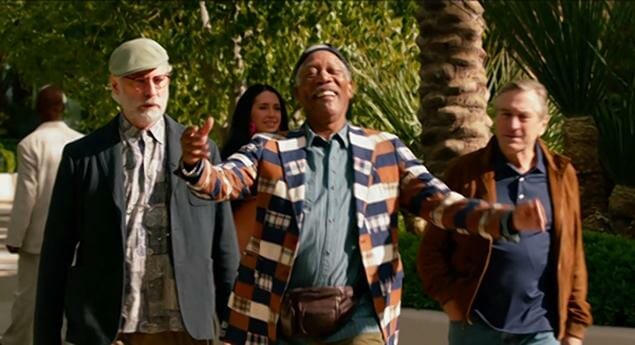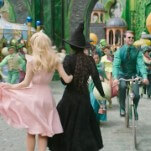Last Vegas

On the theatrical poster for Last Vegas, the film’s four decorated leading men all appear rather elegant, the one-sheet’s black-and-white hue only serving to add classiness to their perfect teeth and silky-smooth suits. Give them each a clean glass with some ice cubes, and they could be selling a new whiskey brand. What’s ironic about this is that the film Last Vegas derives most of its enjoyment factor from its actors’ clear-as-day willingness to make themselves look as old, absent-minded, and out-of-touch as possible. Rare is the scene here that doesn’t make some passing mention of prescription medication for sore joints, or the characters’ inability to perform any kind of physical task without collapsing onto the floor. That the actors are so game in this regard is the film’s most amusing quality.
Director Jon Turteltaub (National Treasure, The Sorcerer’s Apprentice), working from an original screenplay by Dan Fogelman (Tangled; Crazy, Stupid, Love.), begins the film with a Brooklyn-set blast from the past. Over the opening credits, the childhood versions of the film’s marquee actors—along with a girl named Sophie, who will come to serve an important role in the story’s emotional stakes—are shown making a series of funny faces in a photo booth. Not long after, the four boys, who proudly call themselves the “Flatbush Four,” get in an altercation with a few bully-types in a convenience store. They escape the fight, stealing a prized bottle of scotch in the process, and, as they sprint away from the store in a rush of adolescent adrenaline, the film gets a good laugh by cutting to a title card that reads, “58 Years Later.”
On cue, Turteltaub and Fogelman waste no time in presenting a where-are-they-now? series of scenes: Sam (Kevin Kline), in the midst of a forty-year marriage, is living the retired life in Florida, though he has a burst of energy in him that suggests he may not be relishing the aimlessness of post-work life; Archie (Morgan Freeman), also retired, is coming off a stroke, and finds himself tediously recuperating in the New Jersey home of his too-vigilant, married-with-a-kid son (Michael Ealy); Paddy (Robert De Niro) is the only one still living in Brooklyn, though he spends his days cooped up in his ragged apartment, mourning the death of his cherished wife, Sophie (from the prologue); and Billy (Michael Douglas), a successful, high-priced Malibu attorney, has taken the unprecedented step of proposing marriage to his much-younger girlfriend while presenting the eulogy at his mentor’s funeral.
-

-

-

-

- Puzzle By Test Admin July 29, 2025 | 11:13am
-

-

-

-

-

-

-

-

-

-

-

-

-

-

-

-

-

-

-

-

-

-

-

-

-

-

-

-

-

-

-

-

-

-

-







































